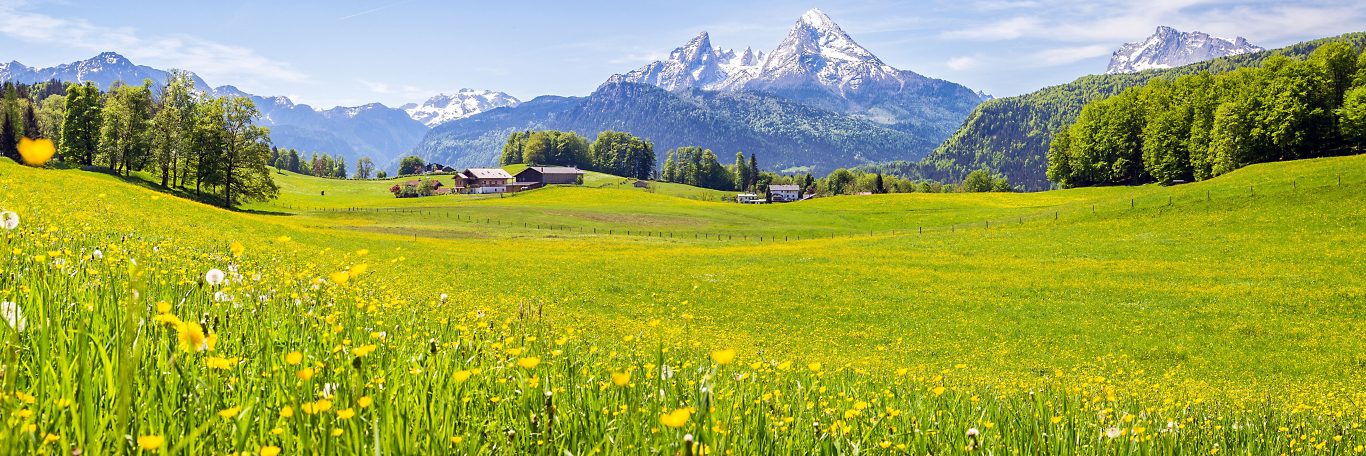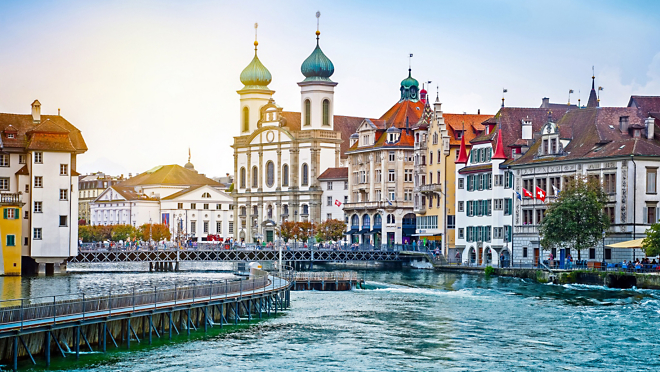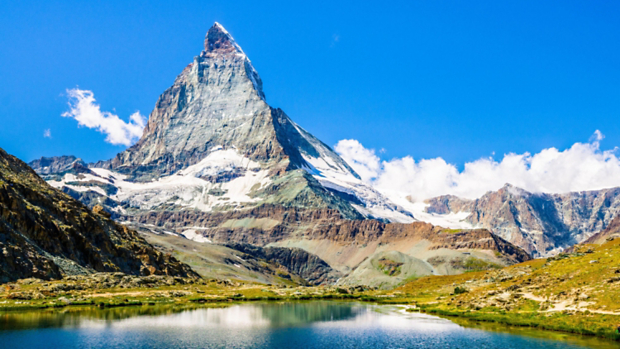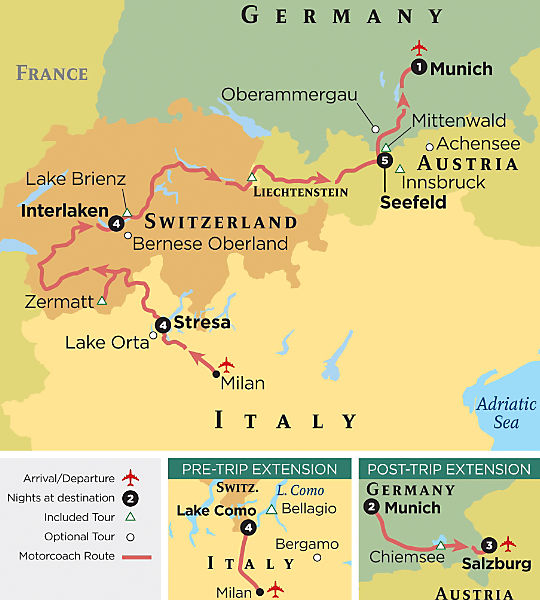You’re receiving this message because your web browser
is no longer supported
We recommend upgrading your browser—simply click the button below and follow the instructions that will appear. Updating will allow you to accept Terms and Conditions, make online payments, read our itineraries, and view Dates and Prices.
To get the best experience on our website, please consider using:
- Chrome
- Microsoft Edge
- Firefox
- Safari (for Mac or iPad Devices)

switzerland
Compare Our Trips

Spend 4 days in Switzerland on
Romantic Villages of Alpine Europe
Land Tour

Spend 2 days in Switzerland on
Romance of the Rhine & Mosel
River Cruise
Spend 5 days in Switzerland on our
Post-trip Extension
Lucerne, Switzerland
Lucerne, Switzerland

Spend 4 days in Switzerland on our
Pre-trip Extension
Basel, Switzerland
Basel, Switzerland

Compare Trips
Add Trip
including international airfare
per day
*This information is not available for our trip extensions. You must reserve the main trip to participate on this extension.
**This information is not currently available for this trip. Please check back soon.
You may compare up to Adventures at a time.
Would you like to compare your current selected trips?
Yes, View Adventure ComparisonSwitzerland: Month-By-Month
There are pros and cons to visiting a destination during any time of the year. Find out what you can expect during your ideal travel time, from weather and climate, to holidays, festivals, and more.
Switzerland in March-May
Spring brings more sunshine, warmer days, and a colorful blanket of blooms to Switzerland’s meadows. Occasional rain showers can also be expected, so be sure to dress in layers and carry an umbrella. Locals take advantage of the milder temperatures and can be found in parks and open-air markets throughout the region. Since the summer crowds have yet to arrive, springtime visitors can enjoy these outdoor activities with fewer crowds.
Holidays & Events
- March & April: Across Switzerland, Easter is celebrated with exquisitely crafted white and dark chocolate eggs and rabbits, but also cuckoos, which are seen as the harbinger of spring. Egg decorating contests and egg hunts are common, and a more somber procession marks Lent.
- May 1: May Day is a public holiday, usually occasioning political protests.
Must See
In Zürich, the end of winter is marked by a day-long festival, Sechseläuten, held on the third Monday of April. Parades are held in the middle of the day, with church bells rung at 6PM. When it gets dark, bonfires are lit to burn the Böögg, a snowman effigy, as a last good riddance to winter.
Watch this film to discover more about Switzerland
Switzerland in June-August
Summer is the best time to experience a temperate climate in Switzerland. Although temperatures will almost certainly drop at higher altitudes, the average range during the daytime is 60-80 degrees.
These months bring weather that's ideal for exploring Switzerland’s thousands of placid lakefronts. Richterswil Horn park is a popular swimming destination due to its optimal location on the shore of Lake Zurich. The park hosts a variety of events on the water in the summer months from a dance party on the beach to an outdoor film festival.
Holidays & Events
- August 1: Bundesfier (Swiss National Day)--This date marks the founding of the Swiss Confederation. Cities and towns celebrate across the nation with fireworks and live music.
Watch this film to discover more about Switzerland
Switzerland in September-October
With the start of fall comes cooler temperatures and a kaleidoscope of foliage. Swiss weather is notoriously unpredictable, but in September temperatures average between 50 and 70 degrees while in October this drops to 40 to 60 degrees.
Switzerland boasts an incredibly bio-diverse collection of fruit trees which become ripe for harvest this time of year. This makes autumn the perfect time to see apple, pear, cherry, or plum trees. Travelers seeking foliage visit Blenio Valley in the Lepontine Alps for preserved old villages as well as an impressive spectrum of colors.
Holidays & Events
- September-October: Alpine Cattle Descent
- Late September-Early October: Festa d’Autunno, Lugano (Autumn Festival)--An open-air celebration of the beginning of fall in Italian-influenced Lugano. Food and drink stalls line the streets and participants enjoy live music, face painting, and a parade.
Must See
The Alpine ascent and descent of cattle is a series of festivals that occurs in early fall. Cows, goats, and sheep adorned with bells and colorful garlands and wreaths are brought down from high altitudes to rural valleys for the winter. This is a fantastic way for travelers to simultaneously witness a crucial cultural event and get a glimpse of small-town life in Switzerland.
Watch this film to discover more about Switzerland
Switzerland in November-December
Although temperatures are fairly unpredictable during the late fall and early winter, they generally hover between the high-20s and mid-50s during the day. Packing warm clothes, especially when exploring regions of a higher altitude, is advisable.
To rid the bones of an inevitable early-winter chill, visitors and locals alike tend to take advantage of Switzerland’s hearty cuisine this time of year. Since November is the middle of game season, dishes featuring wild boar and venison begin to appear on local menus. This is a great time to enjoy an iconic cheese fondue or Alplermagronen, a hearty gratin dish with potatoes and macaroni.
Holidays & Events
- Late November-December: Christmas Markets can be found all over Switzerland for shopping, mulled wine, and stunning light displays
Watch this film to discover more about Switzerland
Average Monthly Temperatures
High Temp Low Temp
Switzerland Interactive Map
Click on map markers below to view information about top Switzerland experiences
Click here to zoom in and out of this map
*Destinations shown on this map are approximations of exact locations
Zermatt

Zermatt is the ne plus ultra of Swiss resort towns. How could it be anything else, with five of Europe’s highest peaks, including the towering Matterhorn? 5,300 feet up the Alps, Zermatt has been a magnet for nature lovers since the 19th century, when hikers began using what was then a village as the launch point for Matterhorn ascents. Its renown spread so far that a veritable who’s who of history (including Teddy Roosevelt and Winston Churchill) has traveled to Zermatt for a climb.
It wasn’t too long before skiers tapped into what hikers had already fallen in love with. Four of the peaks boast ski trails, all of them interconnected, yielding the highest altitude ski resort in Europe (and seventh highest on Earth). With snow guaranteed 365 days a year and jaw-dropping vistas of Swiss and Italian Alps alike, Zermatt soon became a skier’s paradise. When visitors are off the slopes, the lovely town has a little something for everyone: rustic ski bars with bear skin rugs; chic boutiques with the latest designer goods; Michelin-starred restaurants; and even a seasonal igloo-style ice hotel. Whether you’re inside or outside, Zermatt has something for you.
Experience Zermatt with us on:
Basel
Basel is a city where "old" means really old and "new" means ahead of its time. Its historic roots are deep: there’s evidence of habitation in the knee of Rhine River as far back as 5 B.C. and a village was established 300 years later. The Romans set up camp in the heart of what’s now the Old City, launching 2,000 years of continuous settlement on this spot where France, Germany, and Switzerland meet. (You’ll hear all three languages here.)
Discoveries are continually being made in Basel thanks to its status as the global center of the pharmaceutical industry. The pulse of the international art world is taken every year at ART Basel Festival, which turns the city into a magnet for the fashionable, high-rolling set. In fact, art is one of the threads running through the city’s timeline. Not only is Basel home to Europe’s first public art museum established in 1662, but also to the 30 more museums that grace its medieval cobblestone lanes. With its easy-to-use streetcar system and walkability, it’s easy to explore all of Basel’s offerings, before you settle into a café on the banks of the Rhine to soak in the beauty of the setting.
Experience Basel with us on:
Lucerne
If you’ve ever wished you could step into a fairy tale, then consider Lucerne your wish fulfillment. Wrapped in medieval walls and watch towers, boasting ancient covered bridges, and plush with 17th-century architecture, simply walking through the city is transporting. Its Renaissance-era Town Hall and cathedral could be straight out of Sleeping Beauty, but the real star of the show is Chapel Bridge, a 700-year-old wooden footbridge (the oldest of its kind in Europe). Its reflection in the Reuss River has become the symbol of Lucerne.
Goethe sang the praises of the city’s loveliness in the 18th century and the 19th-century arrival of the railroad made its charms more accessible, attracting Queen Victoria, who admired pristine Lake Lucerne. Musicians flocked to the city, establishing a tradition of classical music, opera, and ballet; today, the scene has expanded to include dozens of live music establishments where you can hear jazz, pop, folk, and indie rock. Late each winter, all of Lucerne comes together for a raucous Carnival season, with multiple parades and revelers wearing masks first donned centuries ago. Any time of year, you can follow their footsteps past fresco-decorated homes lining picturesque plazas and feel the defining timelessness of Lucerne.
Experience Lucerne with us on:
Featured Reading
Immerse yourself in Switzerland with this selection of articles, recipes, and more
RECIPE
Embrace the flavor of the Alps with this easy recipe for traditional Swiss Fondue.
Recipe: Swiss Fondue

Fondue was invented by Swiss peasants in the 18th century. With little to eat in the winter but aged cheese and stale bread, these inventive Alpine culinarians found that by melting their cheese in a pot with wine and garlic, their meager provisions became a veritable feast. Soon, fondue’s appeal caught on across all of Switzerland, and even became the country’s national dish in 1930.
Follow along with the recipe below, and gather around a bubbling pot of fondue with friends and family for a memorable meal. The cheese blend that you use will determine the flavor, so feel free to experiment with your own proportions until you find your perfect combination. What you dip in the fondue is up to you—cubes of crusty bread are traditional, but fingerling potatoes, apple slices, and sausage can also be delicious.
Ingredients:
- 1 1/2 cups shredded Gruyère cheese
- 1 1/2 cups shredded Emmentaler cheese
- 1/2 cup shredded Appenzeller cheese
- 3 tablespoons all-purpose flour
- 1 garlic clove, halved
- 1 cup dry white wine
- 1 teaspoon fresh lemon juice
- 1 dash kirsch (optional—can be omitted or substituted with alternate fruit brandy)
- fresh ground pepper, to taste
- 1 pinch nutmeg
- crusty bread, cut into large cubes
Preparation:
- Combine all of the cheeses and the flour in a medium bowl, and toss.
- Use the garlic halves to coat the inside of a 2 quart steel or cast iron pot with an enameled interior, then discard the garlic.
- Pour the wine into the pot and apply medium heat until hot, but not boiling.
- Add the lemon juice and kirsch into the pot, and stir.
- Gradually add the cheese into the wine mixture, one small handful at a time. Stir the pot constantly in a figure-8 pattern, and wait until the cheese has melted before you add another handful. Continue until all the cheese is melted, and the fondue bubbles gently, with the appearance of a light creamy sauce. Season with pepper and nutmeg.
- Remove the pot from the stove and transfer to an alcohol safety burner on your serving table. Adjust the burner flame so the fondue continues to bubble gently.
- Serve with crusty bread cubes at the end of fondue forks or skewers, continuing to stir as you eat, to keep the mixture thin.
Cook Time: 30 minutes
Servings: 6-8
Recipe: Swiss Fondue
Traveler Photos & Videos
View photos and videos submitted by fellow travelers from our Switzerland trips. Share your own travel photos »



